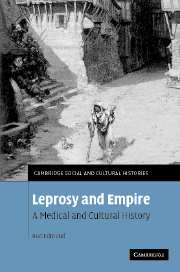Book contents
- Frontmatter
- Contents
- List of illustrations
- Acknowledgements
- Introduction
- 1 Describing, imagining and defining leprosy, 1770–1867
- 2 Scientists discuss the causes of leprosy, and the disease becomes a public issue in Britain and its empire, 1867–1898
- 3 The fear of degeneration: leprosy in the tropics and the metropolis at the fin de siècle
- 4 Segregation in the high imperial era: island leper colonies on Hawaii, at the Cape, in Australia and New Zealand
- 5 Concentrating and isolating racialised others, the diseased and the deviant: the idea of the colony in the later nineteenth and early twentieth centuries
- 6 Writers visiting leper colonies: Charles Warren Stoddard, Robert Louis Stevenson, Jack London, Graham Greene and Paul Theroux
- Postscript
- Index
5 - Concentrating and isolating racialised others, the diseased and the deviant: the idea of the colony in the later nineteenth and early twentieth centuries
Published online by Cambridge University Press: 17 July 2009
- Frontmatter
- Contents
- List of illustrations
- Acknowledgements
- Introduction
- 1 Describing, imagining and defining leprosy, 1770–1867
- 2 Scientists discuss the causes of leprosy, and the disease becomes a public issue in Britain and its empire, 1867–1898
- 3 The fear of degeneration: leprosy in the tropics and the metropolis at the fin de siècle
- 4 Segregation in the high imperial era: island leper colonies on Hawaii, at the Cape, in Australia and New Zealand
- 5 Concentrating and isolating racialised others, the diseased and the deviant: the idea of the colony in the later nineteenth and early twentieth centuries
- 6 Writers visiting leper colonies: Charles Warren Stoddard, Robert Louis Stevenson, Jack London, Graham Greene and Paul Theroux
- Postscript
- Index
Summary
The colony
As European empires spread across the world in the nineteenth century, the meanings and applications of the word ‘colony’ multiplied. Etymologically colony was an agricultural metaphor, from the Latin colere to till, and colonus a husbandman. Thus colonia, a colony, meant an estate in the country or a rural settlement. It was then applied to the new cities that settlers came to from Rome, and the imperial associations of this usage were extended in Greek where the word also had the sense of civilising barbarous people. There is an implicit contrast here between the colonist and the townsperson, or civis, from which the word civilisation derives. A civis, unlike a colonist, is someone whose home does not move. In the early modern period colonies were made by sending people to settle and plant; thus in Hobbes's Leviathan, colonies are sent from England to plant Virginia. Swift, in Gulliver's Travels, offers perhaps the first postcolonial usage of the word:
Ships are sent … the natives driven out or destroyed … a free licence given to all acts of inhumanity and lust, the earth reeking with the blood of its inhabitants: and this execrable crew of butchers employed in so pious an expedition, is a modern colony sent to convert and civilise an idolatrous and barbarous people.
The connection between a parent state and a new settlement is integral to all these usages, and it is the settler who establishes and maintains this relation.
- Type
- Chapter
- Information
- Leprosy and EmpireA Medical and Cultural History, pp. 178 - 219Publisher: Cambridge University PressPrint publication year: 2006

